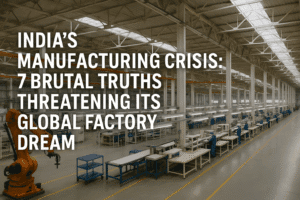India’s Manufacturing Crisis: 7 Brutal Truths Threatening Its Global Factory Dream
India’s quest to become a global manufacturing powerhouse faces both promise and peril. Recent optimism, fueled by Apple shifting iPhone production from China to India, collides with a U.S.-China tariff reduction deal that risks reviving China’s appeal to investors. While India’s exports to the U.S. have surged in sectors like electronics and textiles, its reliance on Chinese components and limited domestic supply chains undercut long-term gains.
Rivals like Vietnam and Thailand, with streamlined policies and cheaper labor, further challenge India’s ambitions. Structural hurdles—cumbersome regulations, skill gaps, and poor infrastructure—stall manufacturing growth, keeping its GDP share stagnant at 15% for decades. Government incentives, like production-linked subsidies, often prioritize assembly over innovation, yielding minimal value addition. To compete, India must slash logistics costs, attract high-value industries, and foster homegrown innovation. Without deep reforms, geopolitical shifts and internal bottlenecks may keep its factory dreams unrealized.

India’s Manufacturing Crisis: 7 Brutal Truths Threatening Its Global Factory Dream
India’s aspiration to become the world’s next manufacturing powerhouse faces a pivotal moment. Recent headlines about Apple shifting iPhone production from China to India sparked optimism, but a sudden thaw in U.S.-China trade tensions threatens to upend this fragile progress. The stakes are high: Can India capitalize on geopolitical shifts to build a sustainable industrial ecosystem, or will it remain a bystander in the global supply chain race?
The US-China Reset: A Speed Bump for India’s Momentum
Last week’s U.S.-China agreement to slash tariffs marked a potential turning point. Overnight, China’s tariffs on goods bound for the U.S. dropped from 145% to 30%, narrowing the gap with India’s 27% duty advantage. While the deal aims to ease tensions, experts warn it could stall India’s recent gains.
“The reset is damage control, not a long-term solution,” says trade analyst Ajay Srivastava. “India’s low-cost assembly lines may survive, but high-value growth—like advanced component manufacturing—is at risk if investment flows back to China.”
Progress Amid Pitfalls: The Apple Example
Apple’s move to shift iPhone assembly to India exemplifies both promise and limitations. While the tech giant’s pivot signals confidence in India’s labor force, the reality is stark: over 90% of an iPhone’s components are still imported, primarily from China. India earns less than $25 per $1,000 iPhone exported, while Apple retains over $450 in profits.
This highlights a critical weakness: India’s reliance on foreign inputs. Without building domestic supply chains—semiconductors, displays, precision engineering—the economic benefits remain superficial. “Export numbers may rise on paper, but real gains require localizing high-value work,” Srivastava notes.
Competing With Asia’s Tigers
Even as India negotiates trade pacts with the U.S. and UK (recently slashing tariffs on whiskey and cars), rivals like Vietnam, Thailand, and Malaysia are sprinting ahead. These nations offer simpler tax regimes, cheaper labor, and proactive trade policies. Vietnam, for instance, now accounts for 10% of global electronics exports, while India struggles to move beyond assembly-line roles.
India’s manufacturing share of GDP has stagnated at 15% for two decades. Government initiatives like the Production-Linked Incentive (PLI) scheme—offering $26 billion in subsidies—have seen mixed results. Smartphone production surged, but critics argue firms often prioritize tariff arbitrage over genuine supply chain development.
The Reform Imperative
For India to break free of low-value manufacturing, systemic reforms are non-negotiable:
- Ease of Doing Business: Cumbersome regulations, land acquisition delays, and infrastructure gaps deter investors.
- Labor Market Flexibility: Archaic labor laws hinder scaling.
- Logistics Overhaul: Poor roads and port delays inflate costs; India ranks 38th in the World Bank’s Logistics Performance Index, behind China (19th) and Vietnam (39th).
- Skill Development: Only 5% of India’s workforce has formal vocational training, limiting high-tech manufacturing potential.
The China Paradox
Ironically, India’s manufacturing push still leans on China. From smartphone components to pharmaceutical ingredients, Chinese imports underpin critical sectors. Some policymakers even advocate welcoming Chinese firms to set up export-focused factories—a strategy that risks deepening dependency rather than fostering self-reliance.
The Long Game
The U.S.-China détente underscores a harsh truth: India cannot rely on geopolitics alone. While trade diversion offers short-term opportunities, lasting success demands a homegrown industrial revolution.
“Slash production costs, fix logistics, and build regulatory certainty,” urges Srivastava. India must transition from assembling gadgets to innovating them, nurturing SMEs, and integrating into global R&D networks.
Apple’s presence is a milestone, not a triumph. India’s factory dreams hinge on transforming its economic architecture—a task far more complex than luring multinational assembly lines. Without bold reforms, the nation risks becoming a pawn in the U.S.-China chessboard rather than a player in its own right. As global supply chains evolve, India’s moment to act is now—or never.
You must be logged in to post a comment.